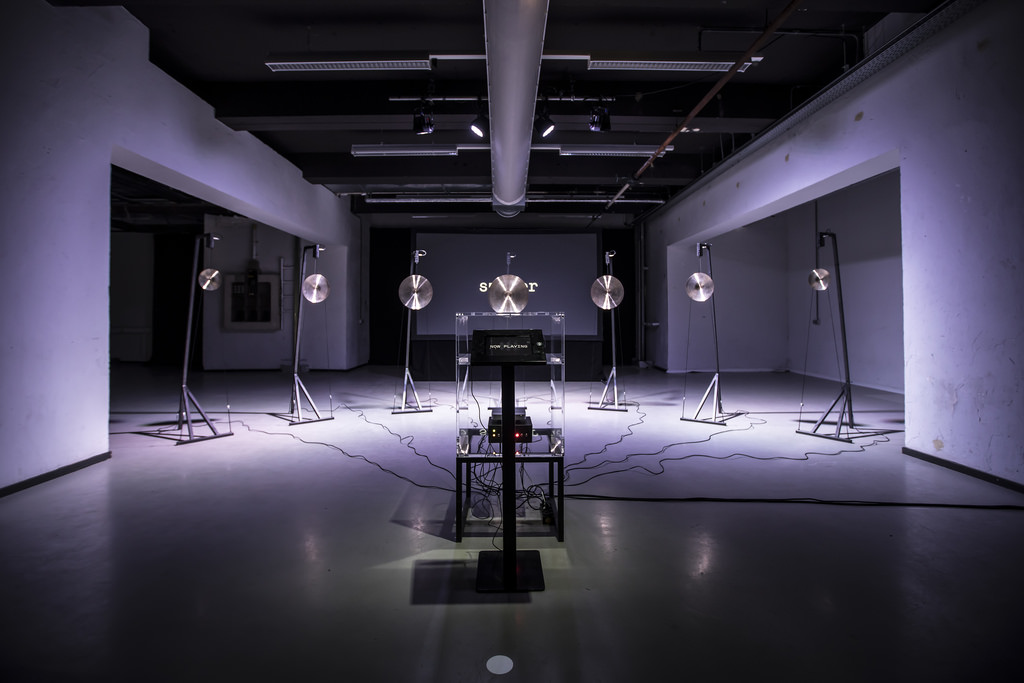
Mike Thompson, Susana Cámara Leret and Dave Young, The Rhythm of Life, 2017. Exhibition view at STRP Biënnale 2017 in Eindhoven. Photo: Hanneke Wetzer for STRP
We all glow. All living cells of bacteria, plants as well as (human and non-human) animals emit biophotons, extremely weak light emissions which cannot be perceived by the naked eye and are used in cell-to-cell communication in living systems. Instruments like photomultipliers tubes (PMT), however, are such sensitive detectors of light that they can detect individual photons.
Back in 2015, Mike and Susana from Thought Collider teamed up with artist Dave Young and researchers at Leiden University to build a kinetic sound installation around a Photon-Multiplier Tube.
The Rhythm of Life, first shown at Museum Boijmans van Beuningen in Rotterdam, offered visitors a chance to listen in on the electrochemical messages transmitted by their bodies, hearing their emissions as complex percussive rhythms. But before placing their hands in the PMT and engaging with the work, the visitors had to agree to donate their personal body data to scientific and artistic research.
Although the transformation of the functional state of the living organism into sound was an important dimension of the work, the artists and designers were also interested in looking at the processes and authoritative gestures that legitimise the collection of personal information and how informed consent is attained and defined.
In the age of the quantified self, what does it mean to donate biological data? How much does it (or should it) matter to us that we can keep control over it? Does this biological data have more value for us than other types of data?
The artists and designers built a new version of The Rhythm Of Life for the STRP Biennale which closed recently in Eindhoven. This time, the visitors started the process by answering a few questions about their health and mental state (are they stressed? have they slept well? etc.) and in return they could sit down on huge beanbags and listen to the data performances of one of the original 56 participants whose data was the closest to their own. At least at that specific moment because light emissions from your body can fluctuate over time, depending on your mental, on your physiological state and of course on your honesty when filling in the questionnaire.
Mike Thompson, Susana Cámara Leret and Dave Young, The Rhythm of Life, 2017. Exhibition view at STRP Biënnale 2017 in Eindhoven. Video by Thought Collider
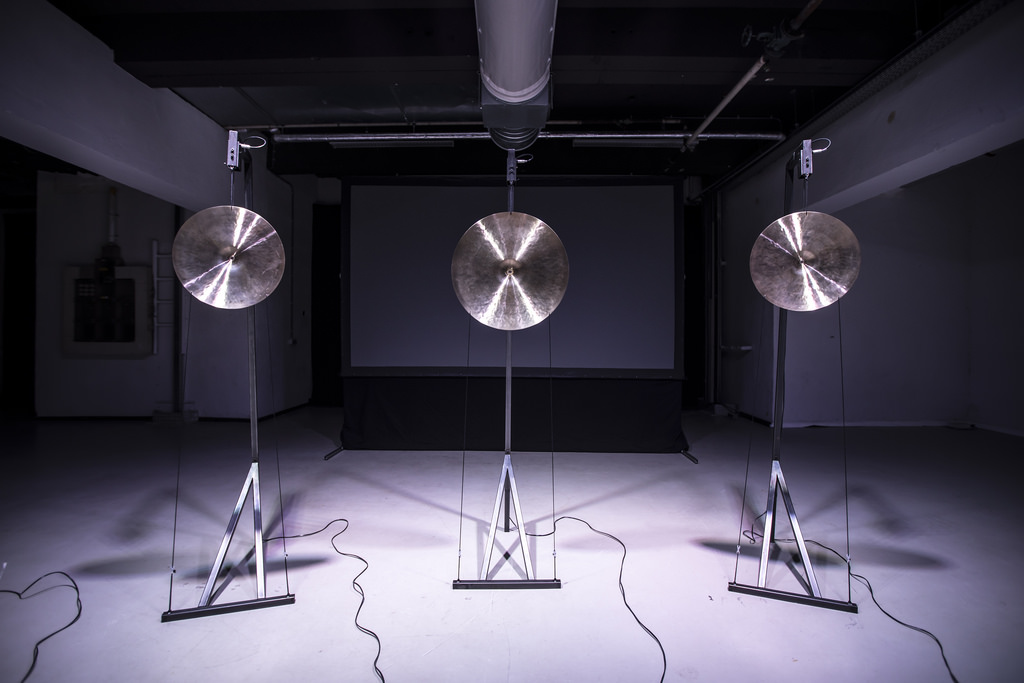
Mike Thompson, Susana Cámara Leret and Dave Young, The Rhythm of Life, 2017. Exhibition view at STRP Biënnale 2017 in Eindhoven. Photo: Hanneke Wetzer for STRP
Unsurprisingly, i had many questions for the artists and designers:
Hi Susana, Mike and Dave! If i understood correctly, the rhythm of life questions what it means to donate your personal data. How different is giving consent to use biodata different from giving consent to use other types of personal data? Are there more restrictions and caveat to be aware of when drafting a consent form?
With the initial installation, the caveat was that your biodata was genuinely destined for use in scientific research. To this end, the notion of consent was both essential from a scientific perspective, and of artistic interest as it enabled our collaborators the Data and Ethics Working Group (of whom Thought Collider and Dave Young are additionally members) to probe the processes and authoritative gestures that legitimise the collection of personal information and how informed consent (written, verbal and implied) is attained and defined. The tension within the work was designed from the placing of a piece of scientific equipment within an artistic context (an art Museum) and the questions of legitimacy that this raises. Due to the nature of the biophoton data, there were certain practices participants were required to perform to ensure the “purity” of the measurements, such as sanitising their hands or wearing a pair of black gloves to block off ambient light. This placed considerable emphasis on the performativity of implied consent during the donation process. The written consent forms for the donation of the data were worded and designed to be as close to legitimate consent forms used within lab practice as possible. Participants had to be informed of the procedure regarding the interaction with the scientific equipment in advance. That said, given that the work is situated within the public context, the form was simplified for ease of use allowing us to quicken waiting times.
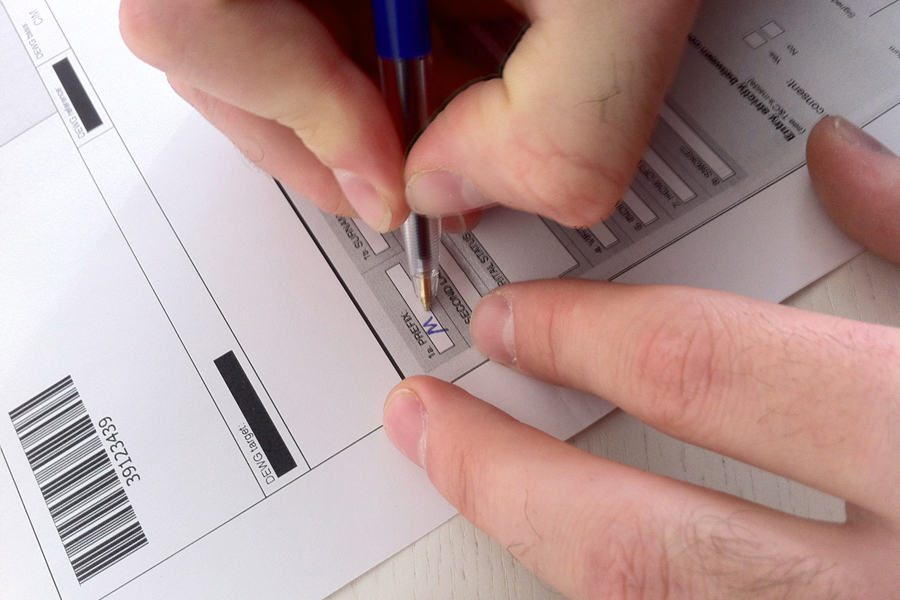
Completing The Consent Form. Photo via Thought Collider
And, as far as you could observe, do you think that people are more comfortable with giving consent to use biodata rather than other data? It does seem rather abstract after all…
Comfortable probably isn’t the word. We’ve certainly seen people nonchalantly answer the questions or complete the forms required within the artwork. The reality is, for most, there seems little thought toward the ultimate destination or ownership of their personal biodata, rather they are too preoccupied with gaining a unique experience with their bodies.
Interestingly, people were more hesitant in answering questions considered more “private”, for example, those related to personal income or the use of medication.
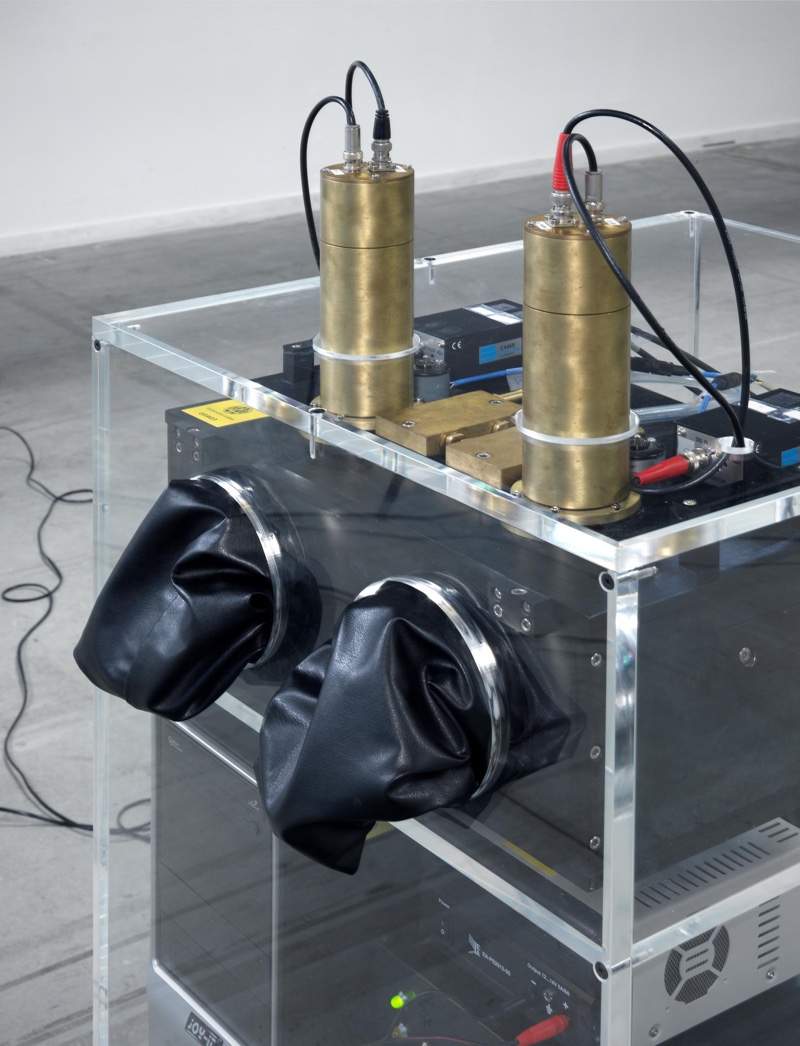
Mike Thompson, Susana Cámara Leret and Dave Young, The Rhythm of Life, 2015. Exhibition view at Boijmans Museum in Rotterdam
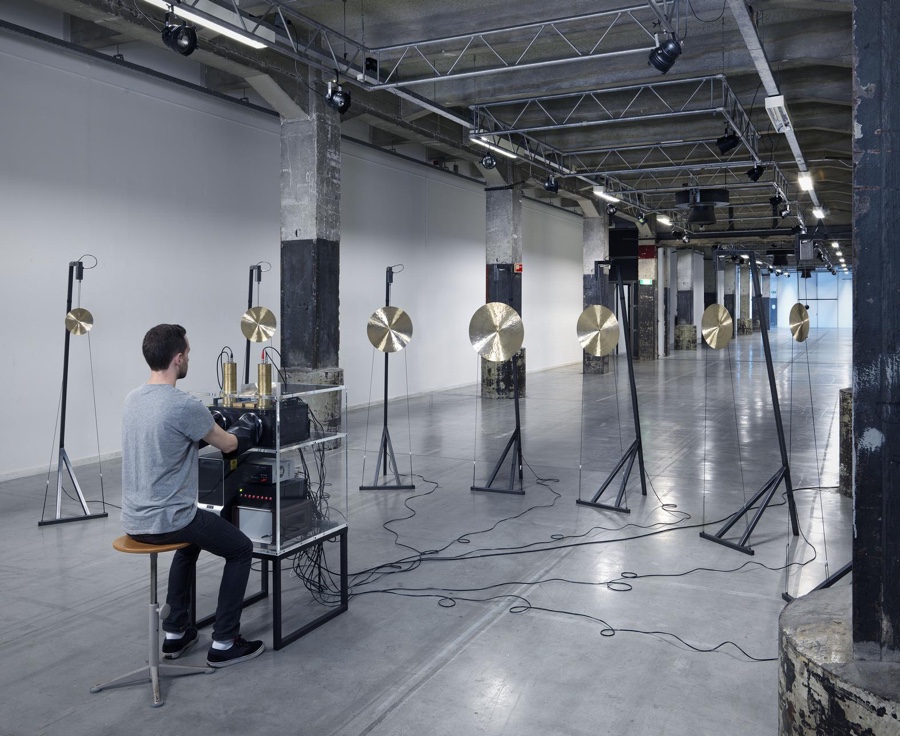
Mike Thompson, Susana Cámara Leret and Dave Young, The Rhythm of Life, 2015. Exhibition view at Boijmans Museum in Rotterdam
What did scientists do with the biodata collected in Rotterdam?
Good question. We are aware that, from a scientific perspective, the validity of the data might be disputed. The partnering artwork developed with the Data and Ethics Working Group deliberately probed the authoritative gestures associated with data consent and ownership, occupying a grey zone between subversive performativity and bureaucracy. In doing so, it operated around, rather than in strict accordance with, a typical clinical methodology demanded in scientific studies. For instance, the final question in the questionnaire asked how honest the participant was in their answers. What might a response to such a question indicate? What might it say about the “validity” of the personal data offered by the participants?
During your presentation at STRP, you explained that it seemed that people who have cancer were emitting more light than the ones who meditate. Are there specific rules, behaviours and conditions that determine how much of this biophoton emission the skin emit? Is this something an individual could manipulate or would want to manipulate for any reason?
Since photon emission is measured over a period of time, researchers are able to obtain more dynamic information about changes in the body. The oxidative degradation of lipids is known to be linked, amongst other things, to diabetes and cancer. The abnormal activation of phagocytes in blood, as a result of the production and damaging effects of oxygen radicals on tissues, led to the realisation that ultra weak photon emissions in blood could be a general marker for diagnosing health/disease. Measurements done in the 80s on blood samples from patients with carcinomas and diabetes, showed higher emission levels than samples from healthy people.
When mentioning meditation, we were referring to a paper written by our collaborators at Leiden University who previously researched its effects on biophoton emission. There does appear to be a direct correlation between those who meditate and a drop in biophoton emission, and vice versa, though the exact origin for this is still being researched. The ability to hear these emissions in real-time opens up a lot of questions regarding the potential of this biofeedback loop, possibly also as a self-regulating process. Exactly how this would work or whether one could or would want to manipulate this is still an open question which brings up thoughts regarding the sub-conscious effects of biofeedback processes, for better or worse. This is something we hope to explore further in the near-future.
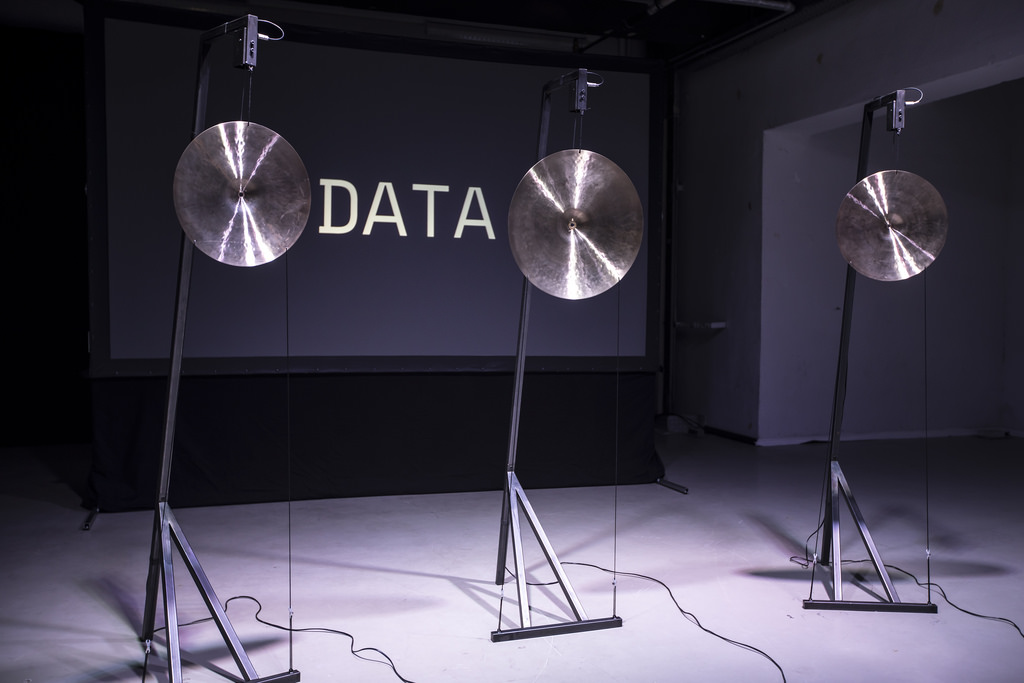
Mike Thompson, Susana Cámara Leret and Dave Young, The Rhythm of Life, 2017. Exhibition view at STRP Biënnale 2017 in Eindhoven. Photo: Hanneke Wetzer for STRP
Dave Young developed the sound dimension of the work, right? I’d be interested to know more about the decision process behind the final setting. How was the data matched to the sound compositions? How do they correspond to each other? And why chose this set of instruments?
On a technical level, the rhythms are generated according to three pairs of algorithms (the signal intensity and fano factor slope of the left and right hands, and the asymmetry and correlation between them) which the team at Leiden University were using in their own studies of biophoton emissions. These algorithms are used to subdivide each beat into different rhythmic quantities: a higher intensity emission recorded from the left hand for instance would equate to a faster rhythm on the corresponding cymbal. Played out over the whole setup, you can hear for instance how rhythms played out on the left hand are echoed on the right hand moments later, whereas the rhythms on the asymmetry cymbal might create curious phasing effects with the correlation cymbal. In terms of the aesthetic qualities of the sound, our methods for translating data into rhythm are heavily inspired by the music of polyrhythmic percussion ensembles, and gamelan ensembles in particular. The cymbals were produced specifically to have a gong-like quality – each cymbal pair has a distinct resonant pitch that helps the participant to identify where a given rhythm is coming from, as well as creating a meditative interplay of tonalities. Additionally, we were very inspired by mid-20th century minimalism and systems music. Steve Reich’s Clapping Music is a good example of an algorithmic approach to composition – an incredibly economic idea that generates great complexity through offsetting simple rhythms against one another. We were trying to evoke such qualities in our approach to data-sonification.
Why did you think it was important to add a sound dimension to the experience? Why not stick to the visual aspect of the phenomenon?
Biophotons are emitted within the visible light spectrum and although sensors in our retinas can respond to individual photons, neural filters prevent us from eliciting a conscious response. They become “invisible” to the naked eye, to prevent us from constantly seeing too much noise in the low light range. Therefore as a communicative process, it exists beyond the range of our conscious (human) perception. As we mentioned above, there was an interest in the rhythmical qualities of biophoton emissions and, from the perspective of “sensing data”, we were triggered by possibility of making this communicative process perceptible. As sound is absorbed through the whole body, we were most triggered by the ambiguous experience of the fluctuations in these body emissions over time, to think more abstractly about the meaning and experience behind these rhythmical patterns.
This is the second iteration of the project. Are you planning to develop other versions of it?
The great thing about the work is that it was designed so that it can be easily reconfigured to pose other questions either of the existing data or via data collection. The performative aspect of the work is something we’re interested in, especially given that the installation is quite intimate and personal, yet simultaneously very public. Some time ago the idea was floated that if we had an identical second installation, two participants could experience their biophotons simultaneously, allowing us to monitor whether one individual’s emissions influence the other. We are hoping to to continue investigating the notion of biofeedback through these and other ideas.
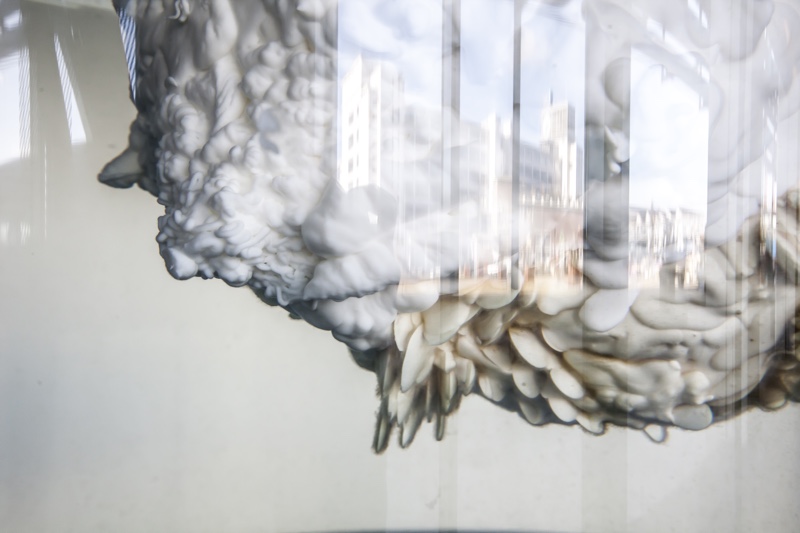
Fatberg, MU Eindhoven
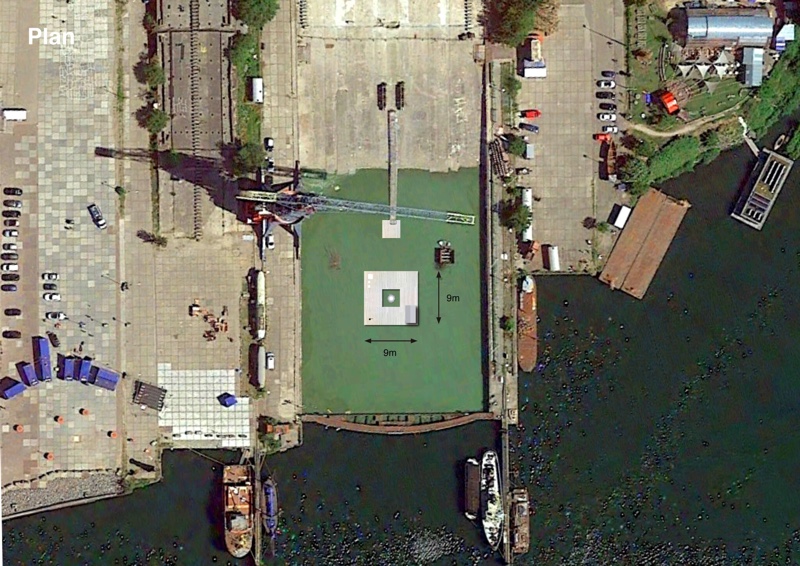
Fatberg
And since i have you here, could you tell us how things are shaping up for The Fatberg?
It probably looks like things went quiet but things are in fact quite the opposite. 2 weeks ago FATBERG moved into its new home at NDSM Shipping Wharf in Amsterdam Noord. Here, in the coming months, together with MU Artspace, Stichting NDSM, architects Space&Matter and construction company Autarkhome, we are working on a floating construction site, for building the island of fat, consisting of movable pontoons. To do so we are using an innovative foam concrete, allowing each pontoon to be designed and built with a specific function in mind, from the collecting and rendering of fat, to a visitors centre including a small lab and office facility. This all new floating FATBERG site will not only allow us to finally bring FATBERG to island size, but act as home for a public programme, where we will schedule events investigating fat and its cultural, economic and social relevance as well as to infuse it with new meaning. So please keep your eyes on the FATBERG website, and social media for updates – there will be a lot happening very soon.
Thanks Dave, Mike and Susana!
Previously by Mike Thompson from Thought Collider (together with Arne Hendriks): FATBERG. Building An Island of Fat. And by Dave Young: The Reposition Matrix.
